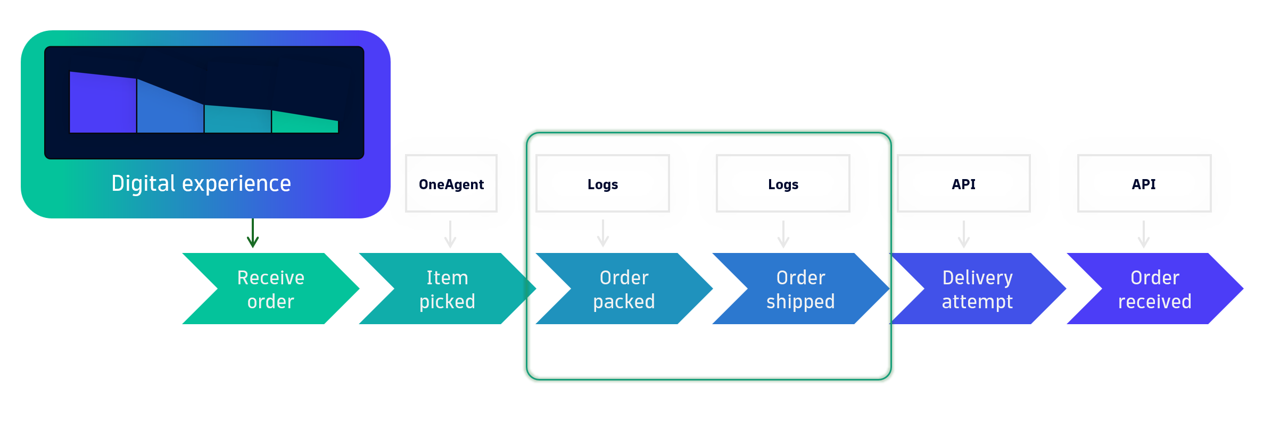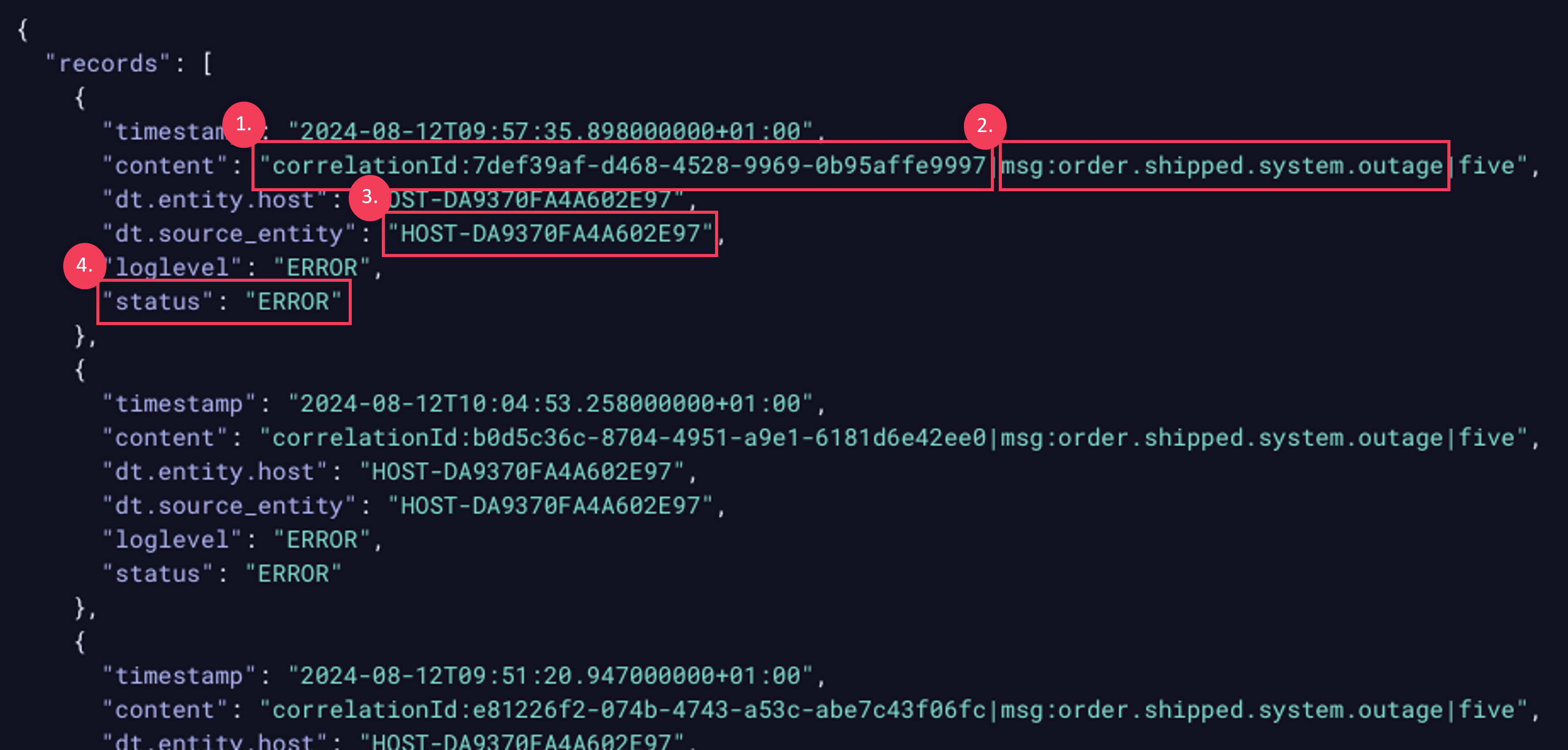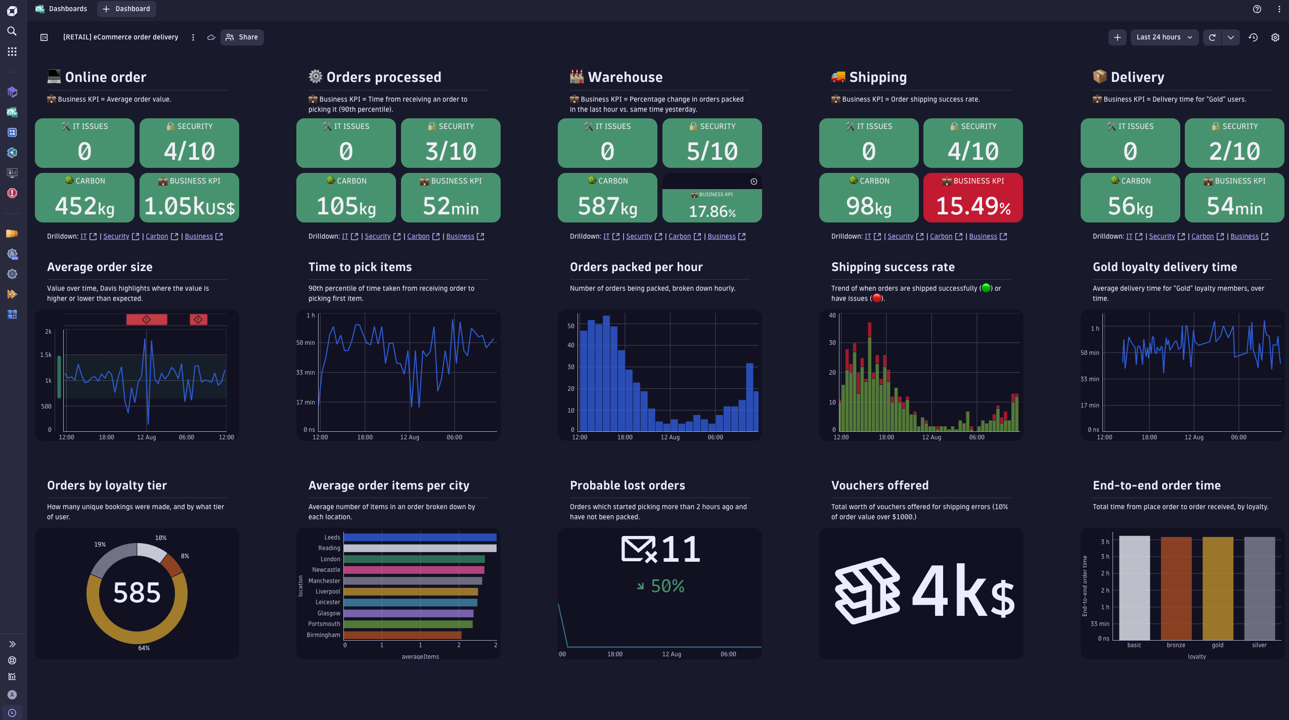Organizations in today’s data-driven world often struggle with fragmented data sources that hinder comprehensive business insights. With Dynatrace OpenPipeline, you can ingest logs from any system and extract relevant business data to get a cohesive end-to-end view of your business processes.
Unrealized optimization potential of business processes due to monitoring gaps
Imagine a retail company facing gaps in its business process monitoring due to disparate data sources. Due to separated systems that handle different parts of the process, the view of the process is fragmented. On top of that, the data sources are inconsistent. While some data comes from modern systems with APIs, other data stems from older systems that generate log files, and some data originates from external vendors. This inconsistency complicates uniform gathering and data analysis, resulting in incomplete or inaccurate insights. This scenario is shared among large organizations that rely on multiple internal and external systems for data collection.
 Figure 1. Incomplete view of the ordering process due to older systems
Figure 1. Incomplete view of the ordering process due to older systemsGet business process observability across data silos with Dynatrace OpenPipeline
Traditional observability platforms often focus on technical metrics and logs, which are essential for troubleshooting, but they don’t take business value into consideration. Dynatrace OpenPipeline goes beyond this by offering the possibility of extracting business-relevant data from logs and using them to monitor end-to-end business observability.
In our retail company example, older systems are involved in shipping the order. They only produce logs that have not yet been monitored from a business perspective, although they contain valuable business information.
By leveraging Dynatrace OpenPipeline, the retail company can integrate data from all sources across the whole process, including Dynatrace OneAgent®, logs, and external business tools. This approach ensures that the company can easily track the entire journey from online order to its successful delivery.
 Figure 2. Extracting business events from logs enables an end-to-end view of the ordering process
Figure 2. Extracting business events from logs enables an end-to-end view of the ordering processBenefits of capturing business events
Logs often contain valuable insights into your business; however, this information can be difficult to process, particularly as you probably only need data from some specific log lines.
Dynatrace OpenPipeline extracts this business information from logs and stores it as a separate data type, so-called business events. This has several advantages:
- Separation of concerns: Logs are often used for technical troubleshooting. Extracting business events allows for a clear separation between technical and business-relevant data.
- Access control: Different teams can access different types of data. For example, support teams might access logs for troubleshooting, while business teams access business events for analytics.
- Ease of access: Having business events in a uniform format simplifies querying and visualization, making it easier to analyze and derive insights.
How to find valuable business information in logs
In our example of a retail company, we need to extract business information from shipping logs to know if our order has already been shipped. See a typical log file with shipping details below.
 Figure 3. Log file with business information
Figure 3. Log file with business informationFrom this log file, we can identify and capture the following business information:
1. Correlation ID – The Correlation ID is part of the log payload and identifies this event in the context of a business process.
2. Message – The message is also part of the log payload and contains information on which part of the business process it represents.
3. Context – The context contains information on which IT system handled this part of the business process.
4. Status—The status information tells us if something was successful or if we hit an issue.
Use OpenPipeline to identify relevant log events
To turn this information into a business event for analytics, we utilize the capabilities of Dynatrace OpenPipeline to identify relevant log events, parse the data, and create a business event out of it. The approach is the following:
- Go to the OpenPipeline app (available by default in your Dynatrace tenant)
- Create a route that specifies which logs should be processed. For example, you can only process log events coming from a specific ingest source or containing a specific phrase in its log message.
- Define a pipeline that will process these logs.
- Configure the data extraction rules within the pipeline. This involves:
-
- Extracting correlation IDs: Identify and extract correlation IDs from the log content. Rename these IDs to make them uniform with other events (for example, rename “order ID”).
- Extracting the message: The relevant message will be extracted from the log content and used as part of the business event.
- Parse out contextual information such as the context (which is the related host) or status information in our case.
- Defining event types: Specify the event type using the extracted message and provider information. For example, you might name the provider retail.logs for consistency.
The extracted information is re-ingested into the pipeline as a new business event. The event is then stored in Grail™ datalake house and can be used for further analysis or process visualization.
Do you want to dig deeper into extracting the data? Watch the dedicated Dynatrace Lab episode with Andreas Grabner and Alistair Emslie for a step-by-step guide on how this is done:
Turn your business data into tangible value
The extracted business data enables you to optimize your processes and gain valuable new insights. You can easily create a dashboard like the one below: it provides the example retail company with real-time data and KPIs, such as the success rate of shipping orders. Unlike traditional dashboards focusing on specific applications or technical aspects, this dashboard tracks the performance of the complete business journey with business KPIs and metrics, utilizing the information extracted from the log files.
Of course, you can also leverage the full power of the Dynatrace platform, like AI-powered monitoring of your business KPIs through Davis® AI. You can also visualize the end-to-end process flow in our Business Flow app, which enables you to identify delays, errors, and exceptions, providing insights into IT and business-related issues.
 Figure 4. A dashboard provides a holistic view of business process performance
Figure 4. A dashboard provides a holistic view of business process performanceLearn more about the capabilities of Dynatrace OpenPipeline
If you’re struggling with gaps in your business process monitoring caused by disparate data sources and outdated systems, consider how Dynatrace can transform your approach.
To learn more about Dynatrace OpenPipeline capabilities, see our documentation.
 4 months ago
47
4 months ago
47